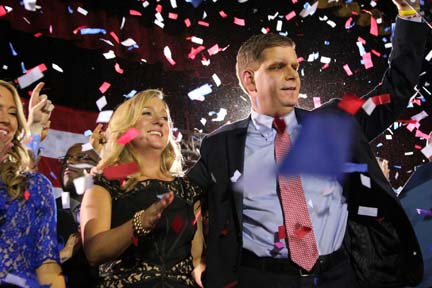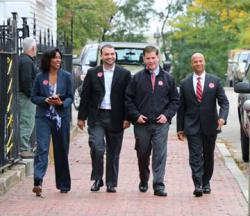November 6, 2013
 Marty Party: The mayor-elect celebrates with his partner Lorrie Higgins. Photo by Mike Deehan
Marty Party: The mayor-elect celebrates with his partner Lorrie Higgins. Photo by Mike Deehan
It’s been a long time coming. Many skeptics thought it would never happen. And, yes, it could prove fleeting. But for one day in November 2013, residents of the city’s largest neighborhood put aside long-standing differences to elect one of their own to the most powerful job in Boston and, arguably, the state.
Marty Walsh didn’t win white Dorchester. He didn’t win black Dorchester. He won Dorchester. Period. And he did it in convincing fashion, carrying more than 60 percent of the vote in his home neighborhood.
Yes, he did better in “white” neighborhoods than he did in “majority-minority” precincts. His seaside House district was always going to be his Fort Knox. But who would have guessed that Marty Walsh – who until six weeks ago had never appeared on a ballot west of Washington Street – would score decisive wins in Four Corners, Grove Hall, Lower Mills, and Mattapan Square.
Dorchester has always had this potential, but time and again, we’ve stumbled as we traipsed through the underbrush of a bygone Boston. A knotted root-system of racial, ethnic, and geographic roadblocks has trumped neighborhood time and time again.
This time it was different.
 Team of Rivals: Richie, Arroyo, Walsh and Barros. Photo courtesy Walsh campaignThe iconic image of this election will be the one shot taken outside of First Parish Church on Meetinghouse Hill — the historic center of civic, religious, and political life in this town-turned-neighborhood – showing Walsh, surrounded by Felix Arroyo, John Barros, and Charlotte Golar Richie, in full stride, walking to meet the camera array set up to capture Richie’s dramatic endorsement of her Dorchester neighbor.
Team of Rivals: Richie, Arroyo, Walsh and Barros. Photo courtesy Walsh campaignThe iconic image of this election will be the one shot taken outside of First Parish Church on Meetinghouse Hill — the historic center of civic, religious, and political life in this town-turned-neighborhood – showing Walsh, surrounded by Felix Arroyo, John Barros, and Charlotte Golar Richie, in full stride, walking to meet the camera array set up to capture Richie’s dramatic endorsement of her Dorchester neighbor.
By election day, this “Team of Rivals” image had been hung on fence posts from Dudley to Cleary Square – Exhibit A in the tough-sell argument that a 46-year-old Irishman labor boss from Savin Hill could pass the sniff test and clear the color line. It worked.
If you think that the endorsements from Arroyo, Richie, and Barros (and yes, other, elected officials of color, including the state senator from Dorchester) didn’t swing this election, ask Marty Walsh or John Connolly. They mattered: Walsh won every precinct in the city’s communities of color.
The knock-out blow came in the single-family side streets sandwiched between River Street and Cummins Highway, where Walsh cashed in on a spike in the city’s second-most competitive district council race of the day. Walsh clearly won the larger share of the Haitian-American electorate that fueled Jean-Claude Sanon’s very respectable 7,879 tally in his campaign against Tim McCarthy for the District 5 City Council seat. While that total was only good for second place for Sanon, it helped to propel Walsh into a more comfortable three-point lead citywide.
Notching marginal wins in East Boston, Allston-Brighton, and Charlestown helped the Walsh cause, no doubt, but Hyde Park – which forms the bulk of Super-Ward 18 – was the biggest prize of the day. Stunningly, Walsh ran the table there, a clean sweep of all 23 precincts.
Walsh won the mayor’s chair on the margins, but his victory was anchored in his House district, which churned out lopsided totals for Galway’s favorite grandson. Wards 13, 15, and 16 effectively cancelled out Connolly’s West Roxbury base vote tally. The Keystone precinct – Florian Hall’s 16-12 – turned the nozzle to full blast, hammering home Walsh’s best percentage win of the day: an Obama-esque 87 percent that deposited a cool 790 ballots into his kitty. Connolly’s best percentage precinct of the day was in Beacon Hill’s Ward 5, precinct 5 where he posted an 89 percent win by capturing 289 ovals. Clearly, Connolly would have been pleased to swap those superlatives.
With his Dot base outpacing Connolly’s West Roxbury base, Walsh continued to dominate South Boston, cancelling out Connolly’s advantages in the Back Bay and South End. East Boston was nearly a draw, with Walsh edging Connolly in the end. He won Jamaica Plain and even picked off a couple of Roslindale precincts. He performed better in Connolly’s base than expected as well, winning more than 40 percent in West Roxbury, a remarkable feat.
And so it all came back to the communities of color, the ultimate arbiters of the city’s mayoral future since Sept. 24 at 9 p.m. With some variation, voters of color broke for Marty Walsh, the Dorchester guy, 60-40. It was true in Codman Square, where Marty is a known quantity, but it also carried through into the heart of Mattapan, the Blue Hill Corridor, and deep into Dudley.
Marty Walsh will be the next mayor of Boston because he managed to convince enough voters, many of whom probably had never heard of him until last spring, that he was a better choice than a man they had seen on their ballots a half-dozen times already. He mined the support of their trusted leaders and parlayed that vouchsafe into election day gold.
Marty Walsh – the individual, the politician – gets full credit. It’s his win because people like him, trust him, want him to succeed. Ultimately, he was able to build this remarkable coalition because he treated people well over many years and, even when he had to disappoint, he did so with respect.
But make no mistake: This is a victory for this neighborhood, too. Much maligned, often dismissed, we did it largely to ourselves through the years. But Dorchester finally figured it out: We’re a force to be reckoned with and it’s now beyond dispute.
Now, what to do with it?
Topics:


